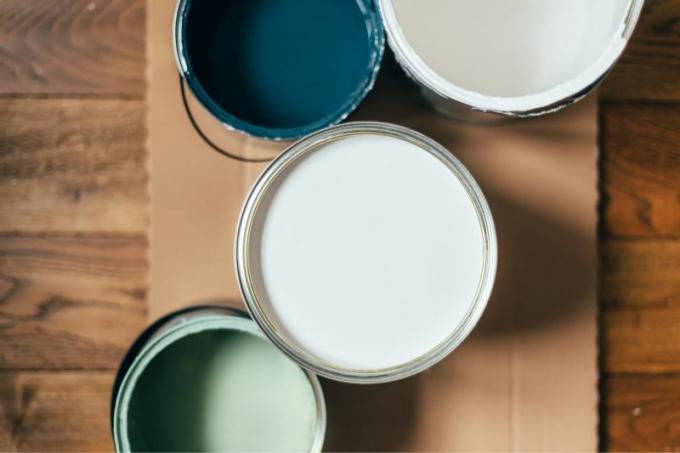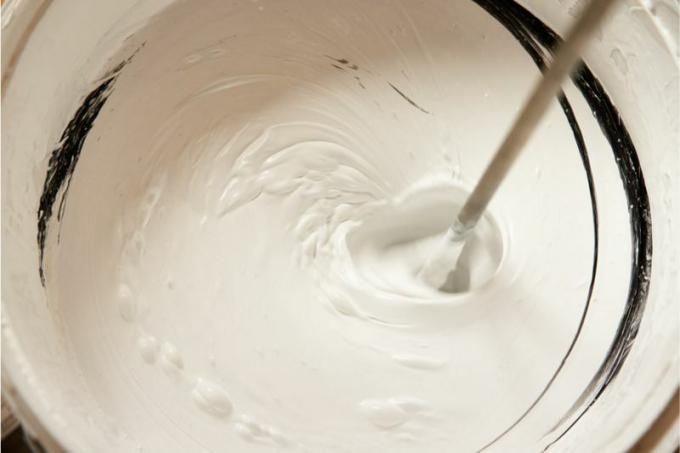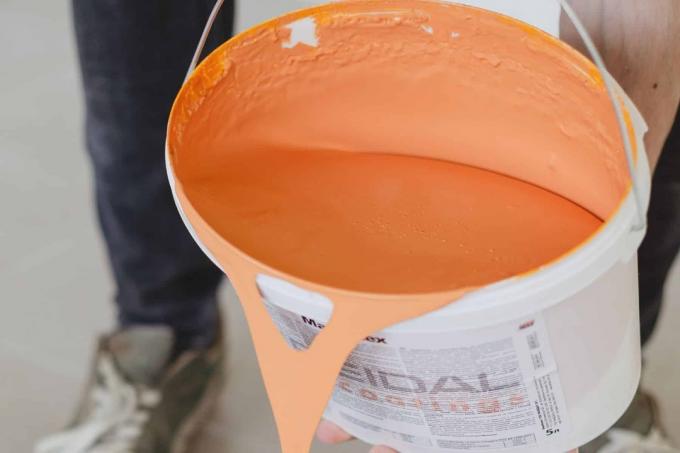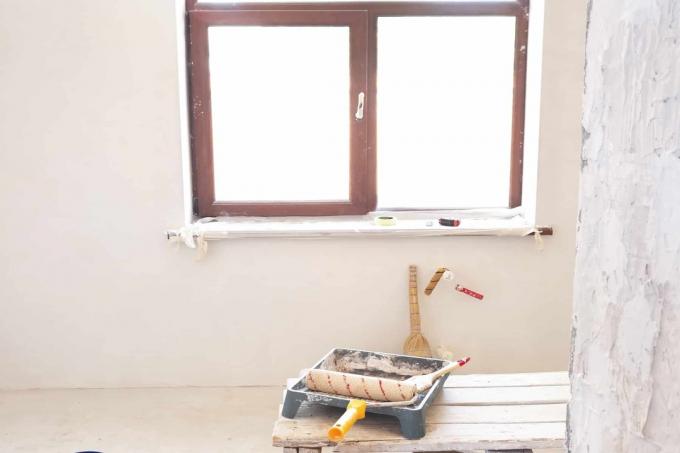

Table of contents
- Recommended amount of water
- Dilute emulsion paint: instructions
- Dilute more types of wall paint
- frequently asked Questions
Opacity is an important factor when using wall paints. Emulsion paints in particular are known for their good covering power, but they are sometimes too viscous or sticky to apply. For this reason, it is important to properly dilute wall paint.
Recommended amount of water
Emulsion paints have the great advantage that they are ready-to-use. That means they don't need to be mixed or diluted before they can be used. However, it may be necessary to dilute them with water if one of the following reasons is present:
- too thick
- sticky

In this case it is worth adding water, otherwise the wall paint cannot be applied properly or lumps may form on the wall. Luckily, water doesn't usually negatively affect the opacity of emulsion paints as long as you keep the mixing ratio in mind. Emulsion paint can be mixed with a maximum of ten percent water to dilute it. More water is not recommended, otherwise sufficient opacity is no longer possible. In addition, it can happen that the paint splashes during application or runs down quickly. The maximum recommended amount can be determined quickly and effectively. For example, if you bought 25 liters of wall paint and want to dilute it, you should use the following maximum amount of water:
- 10% water from 25 liters of paint
- Total amount of water in l = 25 x 0.1 (corresponds to 10%)
- 2.5 liters of water
A notice:
As a precaution, pay attention to possible manufacturer information on the packaging for the amount of water. If another guideline is given there, use it to get sufficient opacity.
Dilute emulsion paint: instructions
Emulsion paints can be diluted with little effort. When diluting, it makes no difference whether the selected emulsion paint was mixed with solvents or not. Once you have determined the amount of water, you can start. The following guide will guide you through each step:
- Open the paint bucket and stir the wall paint thoroughly. It should be a homogeneous mass with no lumps. This makes it easier to absorb the water for dilution. Sticks, for example, which must be sufficiently robust, are ideal for stirring.
- Pour the maximum recommended amount of water into a measuring cup. This makes it easier to regulate the amount added, since you don't have to fill everything into the paint at once.
- Now add some of the water. Five percent is a good start, which corresponds to 1.25 liters of water in a 25-liter paint bucket.
- Thoroughly stir the water into the paint. During the mixing process, check whether the consistency changes. If the paint was too sticky to apply before adding the water, it should now be much easier to use.
- Add the rest of the water to the paint in increments until it reaches the desired consistency. If the water is used up, you should not add more, otherwise sufficient opacity is no longer possible. Continue to stir well so that the paint is suitable for further use.

Dilute more types of wall paint
Emulsion paints are not the only types used as wall paint. There are other types of paint that you can use for painting. But not all of these are suitable for dilution, as they quickly lose their opacity. Wall paints based on lime (chalk paints) and clay are particularly problematic. The opacity of these colors steadily decreases as they are diluted. For this reason, several coats are often necessary to obtain the desired opacity. In addition to these, there are other wall paints that can be mixed with the appropriate thinners.
This includes:
- silicate paint
- dispersion silicate paint
Water will not suffice with these paints as it does not aid in carbonation. For this reason, you need suitable thickeners based on potassium water glass. If you want to use latex wall paint instead, you can dilute it with water. You can do this in the same way as with emulsion paints, but you have to use a different mixing ratio. Add between 20 to 30 ml of water per liter of paint. For a quantity of ten liters, calculate the amount of water as follows:
- Total amount of water: 20 to 30 ml of water per 1 liter of paint
- 20 to 30ml of water x 10L of paint
- Total amount: 200 to 300 ml of water

A notice:
When using thinners, be sure to follow the manufacturer's instructions for mix ratio and application. This guarantees that the desired opacity is retained.
frequently asked Questions
Usually not. Only water-based paints such as chalk or clay paints allow this. Emulsion paints that have dried up because the lid was not properly closed, for example, can no longer be thinned. It's the same with latex paints. Silicate paints usually only harden after use and not in the container. You should then dispose of dried wall paint properly.
No. If the paint is too thin, you need to thicken it. This is only possible with lime or talcum powder. With this you can gradually bind the color. Note that the opacity cannot be restored in this way.
 Maike
Maike
Learn more about paints & varnishes

Cream-colored kitchen: which wall color fits?
If you own a cream-colored kitchen, you don't have to despair with the wall colors. There are numerous shades that go wonderfully with the interior, underline it or create an attractive contrast. We introduce you to 30 wall colors that match the kitchen.

White kitchen: these 30 wall colors match
A white kitchen is the ideal basis for numerous wall colors. They are either selected individually according to your own taste or to match the design of the kitchen. Even combinations are possible. We introduce you to 30 wall colors that match white kitchens.

After painting: ventilation and windows open or closed?
Should you ventilate while painting or only after painting? The answer to this question is more complex than expected. This guide shows what determines whether the windows should be open or closed.

Dispose of wall paint: where and how much does it cost?
Under the appropriate conditions, wall paint can be disposed of in various ways. Because in liquid form, paints are so-called problematic substances that can harm the environment. We will tell you where you can dispose of wall paint and what the costs are.

How long does wall paint take to dry?
Most rooms in the house are used daily. When the walls get a new coat of paint, everything has to happen quickly. But furniture and pictures can only take their old place on the wall when everything is finished. But how long does the wall paint need to dry?

Processing epoxy resin: basics for processing
Epoxy resins have proven themselves as materials and have become indispensable in many areas. Above all, their extraordinary adhesive and sealing function is valued. In order for this to work, the resin must be mixed and processed correctly. More on the basics is here.
